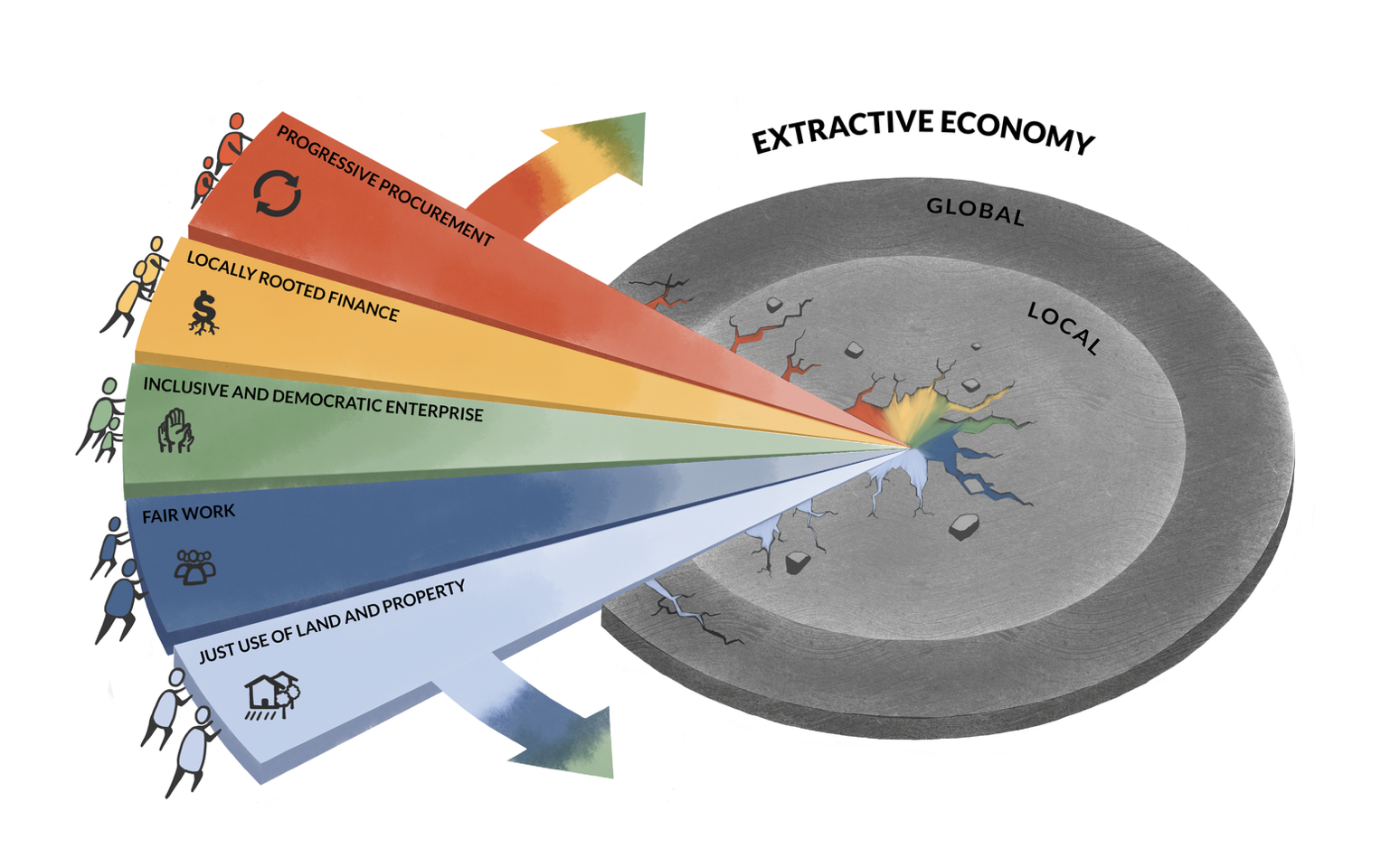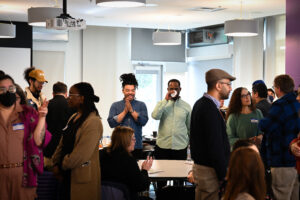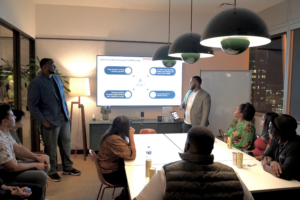According to Movement Generation’s Just Transition Framework, each economy has a purpose, an outcome we choose to manage toward. It may be the accumulation of money and the enclosure of wealth and power, which we see in practice here in Washington, the United States, and many other places across the world. But the purpose can also look different. We can design an economy and manage it toward universal well-being, healthy soil and food, clean water and air, and justice and freedom.
Prior to colonization and enslavement, and even amid ongoing colonization, racism, and exploitation, many Indigenous and Black communities have cultivated economies that manage toward collective well-being. For example, Pacific Northwest tribes traditionally held potlatch ceremonies, through which wealthier community members shared their abundance with those who had less. And across the U.S., Black communities have created mutual benefit associations and other formal and informal networks to ensure community care in times of need, such as death and sickness.
The dominant economy in the U.S. is an extractive economy, built on the foundations of stolen land and slavery. Systemic racism is indelibly ingrained in our current economic system, resulting in a racial wealth gap between Black, Indigenous, and people of color (BIPOC) and white Americans.
The racial wealth gap is traditionally understood as the disparity in wealth between white people and people of color. Hundreds of years of structural racism have deprived BIPOC families of assets and resources that accumulate and transfer from one generation to the next. The racial wealth gap results from the accumulated effects of four centuries of systemic racism that have produced the enclosure of economic power and wealth within white communities and stripped power and wealth from BIPOC communities.
Seattle is one of the most prosperous, educated, and politically progressive major cities in the United States. However, our local histories and socio-economic realities reflect the dominant arc of racial injustice that we see across the nation.
Although local wealth data is fairly limited, Prosperity Now’s 2021 report, “The Racial Wealth Divide in Seattle,” highlights clear indicators of the significant economic disparities that are experienced by BIPOC communities in Seattle:
- 33.1% of Black households and 27.4% of Latino families reported having zero net worth
- Median income for families of color was significantly lower than that of white families:
- 67% lower for Indigenous families
- 58% lower for Black families
- 33% lower for Latino families
- While the homeownership rate was 51% for white families, it was:
- 29% for Indigenous families
- 27% for Latino families
- 26% for Black families
In an effort to address the racial wealth gap in Seattle, in 2022 the City of Seattle’s Department of Neighborhoods (DON) initiated a research project to explore generational wealth building strategies in Seattle’s BIPOC communities.
DON and consulting teams (Headwater Peoples Consulting and People’s Economy Lab) convened a BIPOC Generational Wealth Building Roundtable Group composed of community leaders, entrepreneurs, and active changemakers representing various BIPOC communities and neighborhoods throughout Seattle. The group was engaged for a period of six months to determine a definition of generational wealth to guide the work; engage in learning sessions about BIPOC generational wealth building; provide guidance on research priorities, strategies, and case studies; and identify key areas of interest for data collection.
People’s Economy Lab contributed research and analysis to the project. In September 2022, we presented our research and analysis on generational wealth building to the Community Roundtable. In subsequent discussions, the Community Roundtable determined that a generational wealth building framework wasn’t sufficient. Instead, the project, and ultimately the City of Seattle, should use a community wealth building framework.
Community wealth building is an economic development model that transforms local economies by giving communities direct ownership and control of their productive assets. Community wealth building is a way of organizing our local economies to ensure that they genuinely work for all people. As described above, the racial wealth gap is driven by the extractive nature of our dominant economic system, which is characterized by concentrated ownership, community disinvestment, attacks on labor, environmental degradation, and structural, social, and racial injustice. Community wealth building addresses these realities by laying the groundwork for an economic system where broad and democratic ownership support equity and social and racial justice. Community wealth building supplants the capitalist focus on constant growth, support for large corporations, and maximizing shareholder profit with progressive values and goals like communal ownership, justice, and shared wealth.
The community wealth building framework is especially powerful as the defining framework of a local government. It’s made for cities and localities not satisfied with tinkering around the edges, who are ready to reset the system entirely. It challenges the failing approaches that have been widely accepted in American economic development for too long and addresses wealth inequality at its core. Citywide community wealth building initiatives have been implemented in Chicago, Atlanta, and Cleveland.
Community wealth building includes the following five pillars of direct intervention into local economies:
- Inclusive and democratic enterprise. Cities should have multiple forms of worker and consumer cooperatives, social enterprises, public ownership, municipal enterprise, and more, based on the recognition that the ownership of productive capital is at the heart of where power lies in any political-economic system.
- Locally rooted finance. Cities and local institutions should redirect money in service of the real economy through public and community banks, credit unions, targeted public pension investments.
- Fair work. Every worker must receive a living wage and real power in and control of their workplace for decent work and conditions, and advancing trade union rights.
- Just use of land and property. Cities should mobilize land and property assets to build real wealth in communities, bring local land and real estate development back under community control, and combat speculation and displacement.
- Progressive procurement. Local governments and place-based “anchor institutions” should lead with procurement practices that re-localize economic activity, build local multipliers and end leakage and financial extraction.
We recently submitted a report with recommendations to the City of Seattle Department of Neighborhoods, which will be presented to Seattle City Council soon. We look forward to sharing our recommendations and the City Council’s response in a future blog.
What’s next?
As part of this research project, three community-based partners–Wa Na Wari’s CASE21 Project, Villa Comunitaria, and sləp̓iləbəxʷ (Rising Tides) Indigenous Planning Group–conducted participatory research in three Seattle communities/neighborhoods. We plan to share their findings in future blogs, so look out for those.
In 2023, Community Roundtable members will pilot projects to test some of the community wealth building strategies we researched and discussed in 2022. People’s Economy Lab is excited to continue in a consulting role! We’ll share more as these projects develop.




